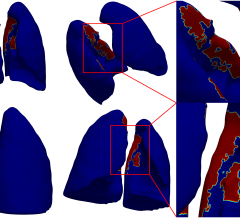March 12, 2015 — An innovative interventional radiology treatment has been found to offer chronic migraine sufferers sustained relief of their headaches, according to research being presented at the Society of Interventional Radiology's Annual Scientific Meeting. Clinicians at Albany Medical Center and the State University New York Empire State College in Saratoga Springs used a treatment called image-guided, intranasal sphenopalatine ganglion (SPG) blocks to give patients enough ongoing relief that they required less medication to relieve migraine pain.
"Migraine headaches are one of the most common, debilitating diseases in the Unites States, and the cost and side effects of medicine to address migraines can be overwhelming," said Kenneth Mandato, M.D., the study's lead researcher and an interventional radiologist at Albany Medical Center. "Intranasal sphenopalatine ganglion blocks are image-guide, targeted, breakthrough treatments. They offer a patient-centered therapy that has the potential to break the migraine cycle and quickly improve patients' quality of life," he added.
Mandato and his team conducted a retrospective analysis of 112 patients suffering migraine or cluster headaches. Patients reported the severity of their headaches on a visual analogue scale (VAS), ranging from 1–10, to quantify the degree of debilitation experienced from the migraine. During the treatment, which is minimally invasive and does not involve needles touching the patient, researchers inserted a spaghetti-sized catheter through the nasal passages and administered 4 percent lidocaine to the sphenopalatine ganglion, a nerve bundle just behind the nose associated with migraines.
Before treatment, patients reported an average VAS score of 8.25, with scores greater than 4 at least 15 days per month. The day after the SPG block patients' VAS scores were cut in half, to an average of 4.10. Thirty days after the procedure, patients reported an average score of 5.25, a 36 percent decrease from pretreatment. Additionally, 88 percent of patients indicated that they required less or no migraine medication for ongoing relief.
"Administration of lidocaine to the sphenopalatine ganglion acts as a 'reset button' for the brain's migraine circuitry," noted Mandato. "When the initial numbing of the lidocaine wears off, the migraine trigger seems to no longer have the maximum effect that it once did. Some patients have reported immediate relief and are making fewer trips to the hospital for emergency headache medicine," he said. Because of the minimally invasive nature of the treatment and the medication's safety profile, Mandato believes patients can have the SPG block repeated, if needed.
While patients reported relief from their migraines, Mandato added that SPG blocks are not a cure for migraines; they are a temporary solution as are other current treatment options for chronic headaches. Because of the minimally invasive nature of the treatment and the medication's safety profile, Mandato believes patients can have the SPG block repeated, if needed.
To further study SPG blocks, Mandato will track how the 112 patients have responded six months after treatment. He is also considering conducting a double-blind, prospective study to more rigorously evaluate the effectiveness of SPG blocks in treating chronic migraines.
For more information: www.sirweb.org


 August 29, 2025
August 29, 2025 









